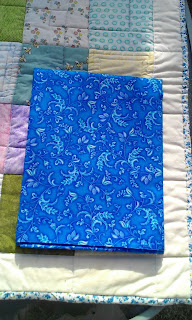When we were at the summer house in May I was
inspired to create a quilt. Quilts are,
however, long in the making. That first spark of an idea needs time to develop
in the back of my brain. And once I
decide on colours and themes and select the fabric there then follows the
actual sewing and quilting. It’s not instant gratification at all!
I’m pleased to say the quilt is done. You can see them in this blog also.
We had a wonderful time at the summer house and because
of that I also wanted to create a smaller version for the summer house. So you
will see there is a cushion. I thought you might like an explanation of the
colours and design I used.
This side of the cushion is a Log Cabin block chosen, as you might have
guessed, in honour of the summer house. The Log Cabin block is an old design,
it is found as a design on the clothes of Egyptian mummies! It was made popular
during the American civil war as a symbol of the pioneering spirit. It consists
of strips of fabric sewing around a central square. Traditionally the central
square is red or orange to represent the hearth of the home. I was inspired by
the fire in the house.
The surrounding strips are traditionally arranged
with the lighter colours on one side, this is the side of the house in the
sunlight, and the darker colours on the other, the part of the house in shade.
The light green is the moss in the forest, the
darker green the trees, the brown is for a moose we saw and the yellow in the inside
of the small flowers that grow all around. I looked them up and in English they
are called wood anemones. The pure white is the petals of the wood anemones,
the patterned white the bark of the birch trees and the light blue the colour
of the lakes. You will see on the quilt I made a colour change; I swapped the
yellow for a mid blue. That blue was the colour of the sky one evening just at
dusk. I used it for the quilt as I felt it represented what I wanted to show
better in that format. For the cushion the yellow worked best.
Log Cabin blocks are arranged in many different
ways when sewing up a quilt. You can see from mine I sewed four blocks together
to create a star shape. That design is called Starry Night and I chose that to
remember a night we went outside to look at the stars. It was beautiful. Of
course there is just one block in the cushion so I couldn’t create a further
design that way. I did quilt a radiating design on the darker side (as I also
did on the quilt) for the twinkling stars.
On the other side of the cushion I used the blue
sky fabric and created a different design. The white triangles are called flying
geese units. You will see they are also on the quilt in different colours used
as a border on two sides. On the last day we were at the house I sat outside
thinking quilt thoughts (as I often do) and pondered what I could use as a
border. As I sat a pair of geese flew over the house. As if by magic!
Hopefully this cushion will find its way to Sweden and live its days in the summer house.






















































